The overlooked deliciousness of lemon peel and pith
Fermented lemon pith, recipe for citrus peel vinegar, some rabbit holes, and news from the farm
Happy Monday!
Ah Spring, staying predictable with its unpredictability. Last week was all sunshine, this weekend we had relentless rain while under the center of the latest atmospheric river to pass over us this winter. This morning, after rain most of the night, the drops turned to fluffy snowflakes, and by the time the sky fully lightened we had an inch on the ground. Okay, to be fair there are still three days of winter left, with the Vernal Equinox arriving later this week. Regardless of the tilt of the sun the tree buds are swelling, verdant green grows across the landscape, and the daffodils all have indicated spring, in this southwest corner of Oregon, is here.
Yesterday, I was unable to concentrate on much with the roaring of the waters to the near south and slight east of us. I can feel the energy. It is busy, curious energy and I can’t sit still in the house. When I am outside I can watch the patterns of the water in endless fascination. The pond next to our home is currently just a pass through from the foaming water rushing out of the forest and down to the larger creek beyond. Last summer we had a beaver couple living in the pond. Before they left they did change something in the back where the water rages in, now it hits a dam of some kind (which I can’t see because of inaccessibility and blackberry cover.) The frothing torrent slows and breaks apart into multiple streams as it enters the pond.
The water leaves the pond in a culvert and continues to splash and rush its way downhill to the creek at the center of this valley. That creek is also raging from all the swollen tributaries and it is working on changing course. Yesterday morning it had a wonderful log jam left a few storms ago and by the afternoon some of those logs were pushed into the bank and others went on their way to the sea. As we are trying to help it become a wild and braided system in the area it runs through our property these changes are welcome. Though I have to say those logs were doing some good work before they headed downstream. I was sad to see them go.
I find this fascinating but I realize most people may not. I write these letters, as just that, a letter to you about what is going on here, with some fermentation mixed in. Today it occurred to me that it is often about the weather, or more specifically, my comments on hot and dry, or wet and flooding. Our seasons are a bit bipolar. When we moved to this land over 27 years ago I wasn’t nearly as aware of the changes in my surroundings as I am now. I see this place and its moods and ecology as a huge influence on my day to day.
I feel myself at the brink of heading off on a tangent of waxing and waning moons but will get on with what I was planning to write this week.
Lemon Pith
I have had this ferment idea in the queue to write about for well over a year. (It is like the pantry in a way, when things are stable and sitting there quietly, they get forgotten.) In May of 2023 we went on vacation with our son’s family. We went south to the land of lemon trees and found ourselves in an abundance of freshly picked lemons. We made all our favorite lemon juice dishes from ceviche to lemon pie.
Our son remembered eating a salad made of the fresh pith of a lemon in Greece a few years earlier. He sliced the pith, sprinkled on oregano and salt, and drizzled it with olive oil. This was so tasty—lemony but not overwhelmingly acidic and no bitterness to be found. We ate quite a few of these salads and still had lemon peels in abundance. Christopher and I separated pith from zest and bundled them up to take home.
You know where this is going. I fermented them.

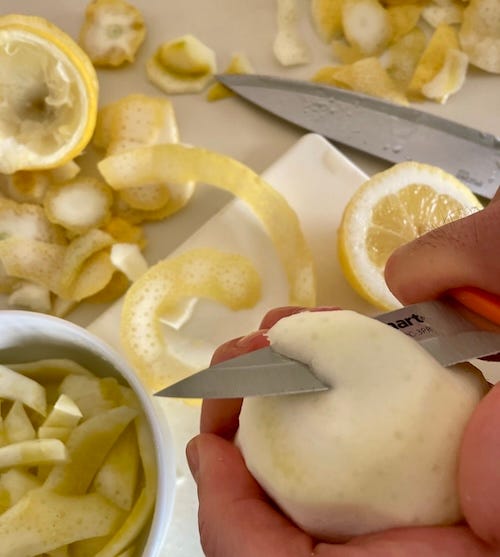
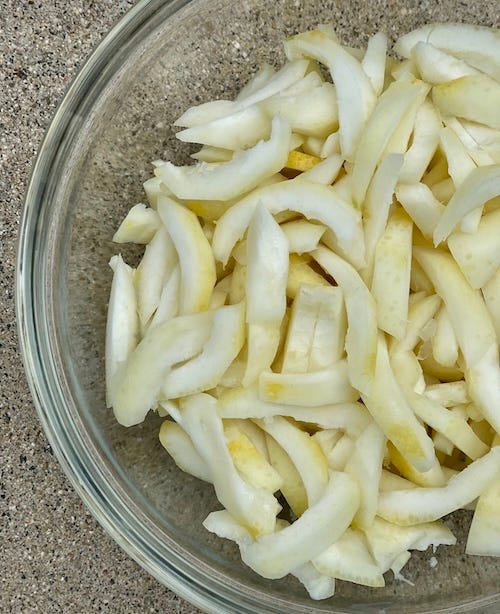

I fermented them with 1.5% salt ratio to weight in a jar. After they were fermented we ate the salad a few times and loved it. When the jar had more air space then ferment I moved them to a vacuum bag to save for the post I had in mind.
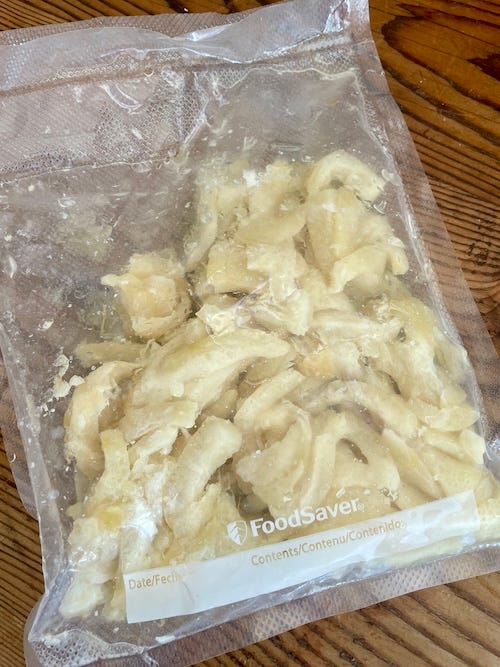
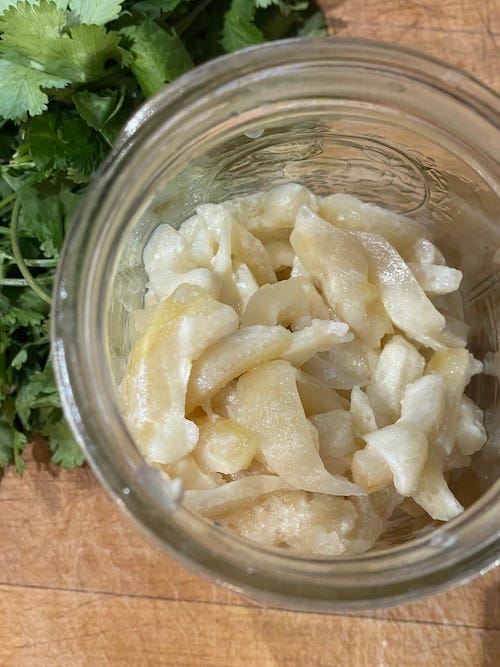
This past week, as part of the Eat Down Your Pantry Challenge, I decided it was time to eat the last of this pith and make the final fermented pith salad. I admit, I loved them so much I kept waiting for that right meal. Things happen, especially when you do silly things like holding on to things you should eat. This week the ferment fridge got too cold and froze a number of the ferments within. All this to say you may hear more about recovery efforts if they work out—the now-frozen fermented artichoke hearts 🤦♀️ for example.
Upon opening the bag I saw the texture was a little too soft. Tasted it, flavor good but mouth feel was well beyond delightful. I decided to lean into the soft a dressing. I put them in a jar and added a tablespoon tahini, olive oil, garlic, cilantro, and a bit of chopped carrot frond. Instead of becoming the creamy dressing I imagined the lemon pith become thick and fluffy. I had a dip, similar to hummus, but light and lemony.

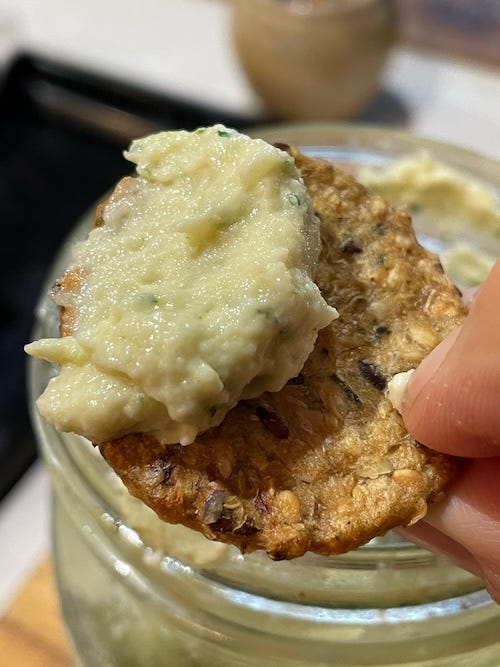
Turns out lemon pith is gut healthy
I know that by the time most of us get a lemon the pith within the peel is shrunken and bitter but I encourage you to taste them here and there and rejoice when you find one you can eat. Funny isn’t it, the whole lemon is edible yet we tend to only eat the juice. Here is a quick rundown. Let’s start with the outer peel (zest)—it is 30% cellulose fiber, naturally occuring waxes to protect the fruit, organic acids, pigments, and lemon oil. Some lemons are also waxed when sold commercially to aid in appearance and shelf life. When consuming the outer peel I prefer to know the source of the lemons and choose organically grown.
The pulp has vitamins, minerals, organic acids, and lemon oils. The pip, or seed, has salicylic acid salts (like aspirin), pectin, limonin, and lemon oils. Just to be clear, I don’t munch down on the pips but I do use them for their pectin in certain applications. I mention pectin in citrus here also.
The pith (today’s hero) has antioxidants (phenolic compounds and limonin) and two types of dietary fiber; cellulose and pectin. Cellulose adsorbs water in the gut and helps to keep one regular. Pectin is a plant-derived polysaccharide and a soluble fiber (meaning it disolves in water). It is an antioxidant and a prebiotic fiber for bacteria that releases butyric acid and other short-chain fatty acids. Like when pectin is used for making jam it also gels in your gut. This can help soften your stool and reduce constipation. It is also thought that this property may help form a protective barrier in your gut lining. It is important to note, as with any fiber, pectin can cause gas in some people.
🐇🕳️
Here is an interesting study that found, “pectin can alter the ratio of Firmicutes to Bacteroidetes in gut and lung microbiota, increasing the concentrations of short chain fatty acids in feces and sera, and reducing the development of airway inflammation by suppressing DC function.”1
Here is another study I haven’t had a chance to read properly because I was watching flood waters instead of going down rabbit holes but it suggests that there are different types of pectin, sometimes within the same fruit. Modulation of the Gut Microbiota Structure and Function by Two Structurally Different Lemon Pectins. It looks interesting and I hope to get to it at some point but I thought those of you that love rabbit holes might enjoy.
More ways to use peels as a zero waste strategy
During the peak of my vinegar obsession I realized anything with sugar could be made into vinegar and anything with deep flavor can be made into vinegar by adding sugar. This was when I discovered citrus peel vinegar. Using citrus peel to reduce waste by extracting every bit of flavor from it before sending it on to the compost remains one of my favorite *discoveries* of that time. Especially with grapefruit peel. When I have grapefruit peel vinegar you can be sure it is first I use up and the least likely I giveaway.
Last week I found this study, Utilization of Lemon Peel for the Production of Vinegar by a Combination of Alcoholic and Acetic Fermentationsdone in China. The team at Shaannxi Normal University was seeing if lemon vinegar was a good use of the lemon peel, a significant by-product of lemon juice production. My low-tech method is to extract flavor and compounds by making a citrus peel sweet tea (so to speak) their process was to add the enzyme pectinase to break the peels down and juice them. This juice was then fermented into a lemon peel wine with an ABV of 5.16%, which tells me these peels also contain a fair amount of sugar.
In the low-tech vinegar I make, I find that there are wonderful citrus flavors. For example, lemon vinegar is a good substitute for fresh lemon juice because it has the flavor of lemons. I can tell you that because I used my low-tech taste system of my nose and tongue. This study showed that the peel vinegar had “a distinct aroma and taste profile that could be distinguished from the lemon juice and lemon wine by the E-nose and E-tongue.”2 I can see where this technology, I hadn’t heard of until reading E-nose and E-tongue (and laughing!), could be useful in determining the finer points of flavors and compounds with consistency across the fermentation but still...
Universal Citrus Peel Vinegar Recipe
Makes about 2 quarts
Universal because you can use this for any type of citrus peel. I have made just lemon and just grapefruit, just lime, you get the idea...but have also made a mix of citrus peels. Citrus peels last well. You can collect citrus rinds in a sealed container for a week or so in the refrigerator until you have enough; if you want to make a larger batch, freeze until you have a quantity. I like to use at least a pound of peels, but there is a lot of leeway here.
Ingredients
1 pound [225 to 450 grams] grapefruit rinds, peels from squeezed limes or lemons, or a combination (see note)
¾ cup [155 grams] sugar, any kind
1 to 1½ quarts [1.5 l] just-boiled water, unchlorinated if possible
½ teaspoon [1 gram] wine yeast
¾ cup [177 ml] unfiltered unpasteurized apple cider vinegar, or your own previous batch
NOTE: Include the pith and any pulp and juice left over after eating the segments orsqueezing the citrus for juice.
Instructions
Put the citrus rinds into a sanitized ½ gallon jar. Add the sugar and enough of the just-boiled water to fill to the neck of the jar.
Stir to mix in sugar and allow to cool to body temperature.
Hydrate the yeast by heating ¼ cup water to 104°F(40°C) and pouring it into cup. Sprinkle the yeast over the warm water, stir gently, and let it sit for 20 minutes.
When the citrus mixture in the jar has cooled to room temperature, add the yeast mixture and stir well with a wooden spoon. Unlike with most ferments, you want to get some oxygen into the mix. However, make sure that all the fruit scraps are submerged under water after you finish; otherwise they can become a host for undesirable opportunistic bacteria.
To keep out fruit flies, cover the jar with a piece of unbleached cotton fabric, such as butter muslin or another tight-weave cheesecloth, clean tea towel, or use a coffee filter. Secure with a string, or rubber band or by screwing the ring onto the jar.
Place the jar on your countertop or other comfortable spot that is around 75°F to 86°F (25°C to 30°C). Stir with a wooden spoon here and there if you remember.
On day 5 or 6 add the raw vinegar. Stir well.
The fermentation will begin to slow down in about 2 weeks. It is time to take out the scraps. When you remove the covering, you may see a film developing on top of your ferment. It is likely the beginning of the vinegar mother. You can remove it and set aside while you are straining out the fruit solids and add it back in, or not worry about it as another will develop.
Check the vinegar in another month. Taste it and check the pH: it should have a nice acidity, and the pH should be 4 or below. It may take another 1 to 2 months to develop.
When ready, bottle the vinegar in a bottle with an air-tight seal and allow to age anywhere for a month. If you like the flavor use it or continue to age. A well-made vinegar gets more and more interesting.
Blanco-Pérez F, Steigerwald H, Schülke S, Vieths S, Toda M, Scheurer S. The Dietary Fiber Pectin: Health Benefits and Potential for the Treatment of Allergies by Modulation of Gut Microbiota. Curr Allergy Asthma Rep. 2021 Sep 10;21(10):43. doi: 10.1007/s11882-021-01020-z. PMID: 34505973; PMCID: PMC8433104.
Ou Q, Zhao J, Sun Y, Zhao Y, Zhang B. Utilization of Lemon Peel for the Production of Vinegar by a Combination of Alcoholic and Acetic Fermentations. Foods. 2023; 12(13):2488. https://doi.org/10.3390/foods12132488


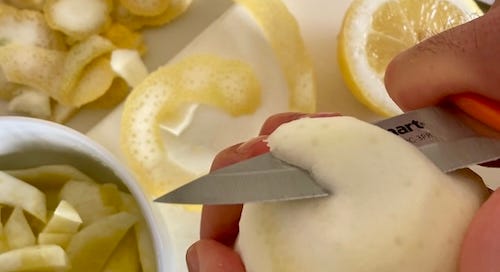



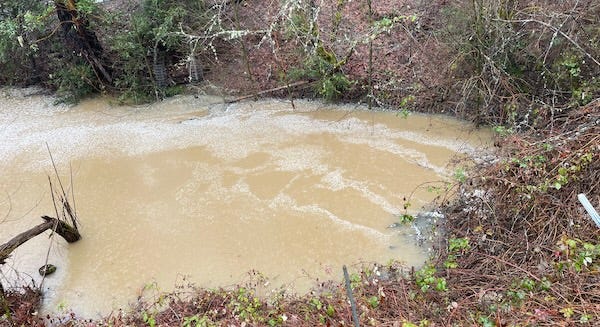

We picked a ton of lemons this year in Tucson. Our friend salt-brined them in quarters. She assures us that when ready, you cut them up into tiny pieces, and they taste like capers. We haven't tried them yet, but I love learning how lemons can be used as there are so many we can access each year for free.
I have a continuous 5 litre ferment going with lemon peels, organic ginger peel and raw honey. Nut I don't drink it (though under more sterile conditions I could) I use it as a base to extract the best colour from Dark purple Viola frlowers and nake it into an ink.